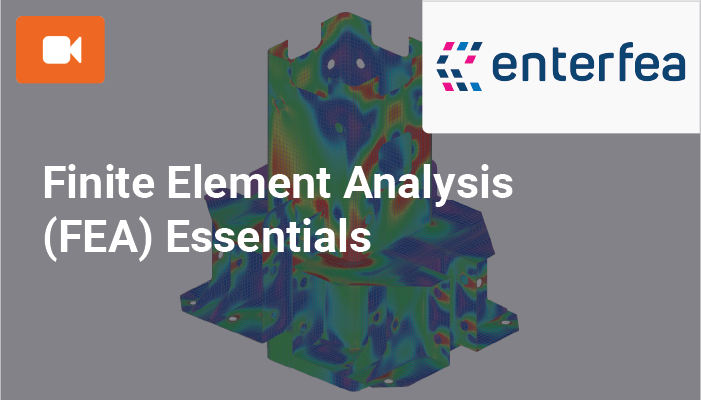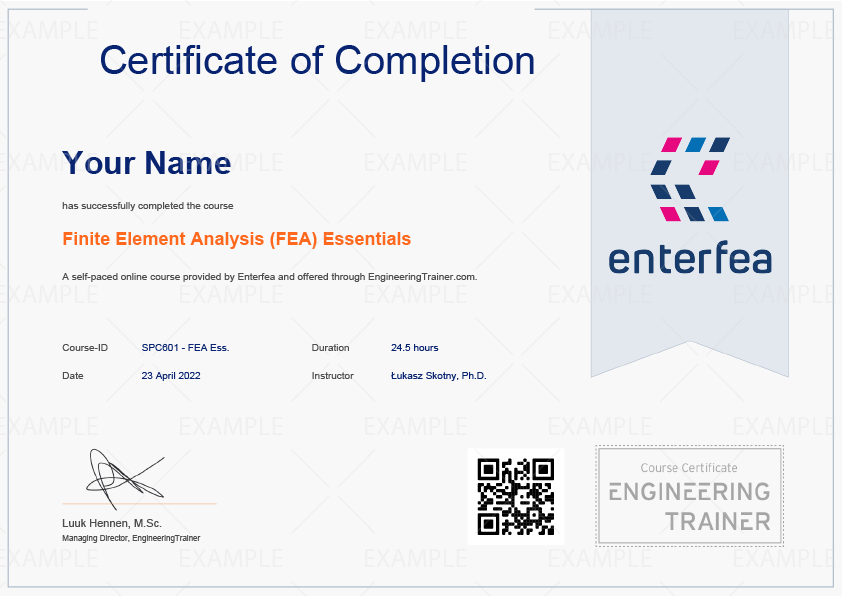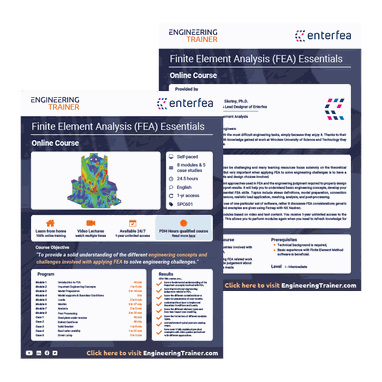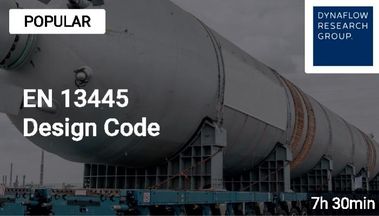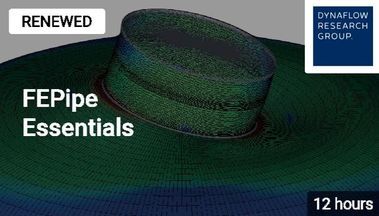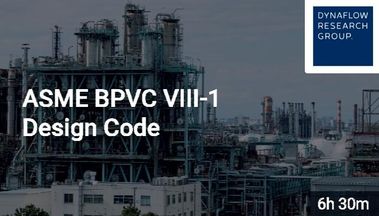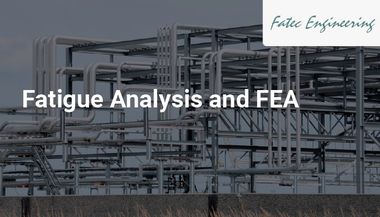Finite Element Analysis (FEA) Essentials
Self-paced Course
8 modules & 5 case studies
EnterFEA
SPC601
Format:
On-demand
Free Course Preview
Help yourself with your purchasing decision. Watch free content now.
Course Objective
"To provide a solid understanding of the different engineering concepts and challenges involved with applying FEA to solve engineering challenges."
Learn from home
100% online training
Video Lectures by Experts
watch multiple times
Available 24/7
1-year unlimited access
PDH Hours qualified course
Read more here
About the course
Self-paced
8 modules
24.5 hrs
English
1-yr access
SPC601
Learning Finite Element Analysis can be challenging and many learning resources focus solemnly on the theoretical backgrounds or on software use. But very important when applying FEA to solve engineering challenges is to have a good understanding of the concepts and design choices involved.
This course teaches you the different approaches used in FEA and the engineering judgment required to properly design models, analyze problems and interpret results. It will help you to understand basic engineering concepts, develop your engineering judgment and gain essential FEA skills. Topics include stress definitions, model preparation, connection rigidity, boundary conditions discussions, realistic load application, meshing, analysis, and post-processing.
This course does not focus on the use of one particular set of software, rather it discusses FEA considerations generic for all software. Demonstrations and examples are given using Femap with NX Nastran.
The course consists of 8 online modules based on video and text content. You receive 1-year unlimited access to the course and the discussions forum. This allows you to perform modules again when you need to refresh knowledge for your work projects.
Meet your instructors
Program & Details
Welcome & Your Instructor
Content Overview
How to use this course
Questions Forum
What is FEA for?
What does FEA do?
How to define a problem?
What is important in FEA
Consistent unit system
Conclusion
What is stress?
Normal Stress and Shear Stress
Stress in 3D
Equivalent Stress
Hooke's Law
Structural Rigidity
Stress Concentrations
Active forces and reaction forces balance
Rigid Body Motion
Conclusion
Importing CAD geometry
Creating geometry in preprocessor
Benefits of simplifying the geometry
Model Symmetry
How to define symmetry in FEA
Small details spoilmesh
How to connect beams to shells and beams/shells to solid
Rigid, semi-rigid and hinged connections in beam models
How to check if a connection is a hinge
How to calculate connection rigidity
Linear material properties
When linear material is not enough
Conclusion
Rigidity of supports
Realistic boundary conditions
Why pinned supports can be rigid!?
How to make an area support
What can and cannot be simplified
Boundary conditions and Hooke’s law
Linear contact – the basics
How to define linear contact
When it is possible to ignore contact?
Typical solutions for contact and BC
Example 1: Cantilever
Example 2: Bolted connection
Example 3: Beam on area support
Example 4: Different rigidity supports
Conclusion
Realistic load values and codes
Characteristic and design loads
Point loads and reality
Force vs Moment
Gravity vs Pressure
Enforced deformations as load
Realistic load distribution
Load distribution: Part 1
Load distribution: Part 2
Load distribution: Part 3
Module 5: Conclusion
Basic elements types
Beam Elements
Plate Elements
Solid Elements
Choosing element type
Higher-order elements
TRI vs QUAD
TET vs HEX
Model Simplifications
RBE – Rigid Body Elements
Plane Strain Elements
Mesh Refinement
Mesh Refinement: Case Study
Mesh Refinement: Challenge 1
Mesh Refinement: Challenge 2
Mesh and Mathematics (M&M!)
Mesh Quality Measures
Module 6: Conclusion
Linear Analysis Setup
Solver vs Pre/Postprocessor
Linear Static Limitations
What does nonlinear material do?
What does nonlinear geometry do?
Contact
Beyond Linear Static
When it is safe to use linear static
Model Checking
Troubleshooting
Module 7: Conclusion
Business advice first!
Stress/Strain/Displacement
The Stress Map!
Stress averaging
Issues with stability
Dealing with stresses higher than yield
Strain as a measure of capacity
Deformations
Beams in FEA
Result verification
Verification with hand calculations!
Business side of the report
Technical side of the report
Module 8: Conclusion
Steel plate under tension
Geometry
Material properties
Boundary conditions
Loads
Meshing
Analysis
Post processing
Conclusion
Bolted Cantilever
Geometry
Material properties
Boundary conditions
Loads
Meshing
Analysis
Post-processing
Conclusion
Solid Bracket
Geometry
Material properties
Meshing
BC and contact
Loads
Analysis
Post-processing
Conclusion
Roof rafter stability
Introduction: Stability design
Introduction: LBA
Introduction: LBA settings
Geometry
Supports / Loads / Mesh
Initial stability conclusions
Critical bending moment calculation
Critical bending moment in desing
Bracing influence on stability
Developing model further: Part 1
Developing model further: Part 2
Verifying assumptions about bracings
Street Lamp
Geometry
Geometry: Base: Part 1
Geometry: Base: Part 2
Geometry: Post: Part 1
Geometry: Post: Part 2
Geometry: The top part
Materials + Properties
Meshing
Meshing: Base plate
Meshing: Base plate: Bonus video
Meshing: Lamp post
Meshing: Top piece
Loads: Wind load according to EN 1991-1-4
Loads: Loading the model
Boundary conditions
BC: Avoid contact with line supports
BC: Dealing with stress concentrations
BC: Defining contact
Analysis
Post processing: Deformations
Post processing: Stress
Post processing: Stability
Post processing: Summary
Course evaluation survey
Your Personal Certificate
Related resources
Rate this course
Results
After this course, you...
have a fundamental understanding of the important concepts involved with FEA,
have improved your engineering judgement related to FEA,
know the different considerations to make for preparation of your models,
understand how best to implement Boundary Conditions and Loads,
know the different element types and how they impact your meshing,
know the limitations of different analysis types,
and understand typical post-processing steps,
have seen 5 fully explained practical examples with video guides and solved with different approaches.
Who should attend this course
Professionals of various industries involved with the execution of FEA projects,
Those managing or overseeing FEA related work that need to be able to provide judgement about the assumptions and choices made.
Prerequisites:
Technical background is required,
Basic experience with Finite Element Method software is beneficial.
Level: Intermediate
Access to the course.
After your purchase is confirmed you receive an account to the EngineeringTrainer online learning portal, where you find the course in your dashboard. After opening the course you will be guided step-by-step through the different modules. You receive 1-year unlimited access to the course. This allows you to perform modules again if this is beneficial for your work projects.
Learn by doing.
The course is mainly based on video lectures. Videos can be viewed as many times as desired. The video lectures help you to grasp the important technical concepts and related actions and considerations are discussed in detail.
This course is self-paced and is not subject to specific dates. The course contains 8 modules with a total of 24.5 hours of content which can be performed at your own pace. A Personal Certificate will be provided to you if you finish the course within the first month after purchase. This incentive will motivate you to perform the course quickly thereby improving your learning curve.
You receive 1-year unlimited access to all 8 modules. This allows you to perform modules again whenever you want to refresh knowledge for your daily work projects.
Participants of this course receive a personal digital certificate if they meet the following requirements:
complete each module of the course,
filling in the Course Evaluation Survey.
Example Certificate:
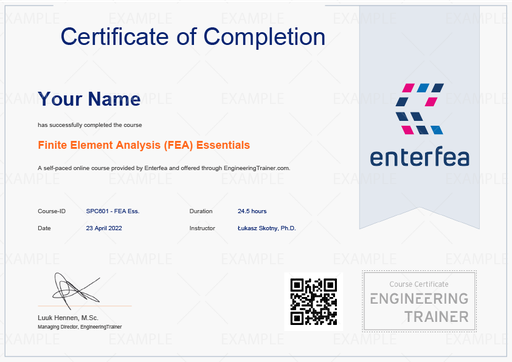
FAQ
Video lectures
Video demonstrations
Explanatory texts & images
Discussions forum with other participants & instructor
No. The majority of training material are videos. These are not available for download, but can be accessed directly with your account on the portal.
You receive 1-year unlimited access to the course. This allows you to perform modules again when you need to refresh knowledge for your work projects.
We encourage participants to submit feedback and questions in the Discussions Forum of the course. These are either answered directly in the forum or form the basis for new videos that are added to the online course on a regular basis.
Participants receive 1-year unlimited access to the course including new videos that are added during this year. Participants receive an email notification upon addition of new course videos.
Examples are provided using Femap with Nastran NX. However, they can be performed by you in any FEM software of your preference.
A free 30-day Femap trial can be downloaded here, which allows you to use the same software as the instructor.
If your computer and internet connection is able to play videos online (YouTube) you will be able to follow the course. Note that almost all browsers are supported, except for Internet Explorer.
